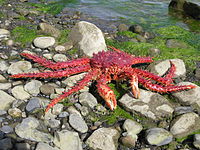
Photo from wikipedia
Abstract The Manila clam, Ruditapes philippinarum, is an economically and scientifically important bivalve mollusk. Its tolerance of aerial exposure has long been considered an important trait for its survival under… Click to show full abstract
Abstract The Manila clam, Ruditapes philippinarum, is an economically and scientifically important bivalve mollusk. Its tolerance of aerial exposure has long been considered an important trait for its survival under acute environmental stress. In this study, the transcriptome sequencing of Manila clam under air exposure and reimmersion stresses were conducted, and the differential expression of stress responsive genes in R. philippinarum were investigated. The expression of metabolic and immune-related genes were significantly affected by aerial exposure and reimmersion (recovery in water). The mRNA expression of Dynein light chain 1 was also significantly affected by aerial exposure, which is enriched in the Vasopressin-regulated water reabsorption pathway. The CTL, C1q, IAP, TLR6, BIRC, BDF and HSP70 were all up-regulated, demonstrating their involvement in stress defense response to aerial exposure. In addition, a number of genes related to apoptosis between AE vs Control, a high rich factor in genes related to primary immunodeficiency between RE vs Control, and a number of genes related to Vasopressin-regulated water reabsorption and energy metabolism were identified. These genes are related to complement pathway, apoptosis, focal adhesion, and HSP signaling pathway, indicating these pathways probably play significant roles in the immune response associated with the aerial exposure stress. This study deepen present understanding of the molecular mechanism underpinning tolerance to aerial exposure and provides useful information for future work on the molecular basis of tolerance of aerial exposure stress.
Journal Title: Aquaculture
Year Published: 2020
Link to full text (if available)
Share on Social Media: Sign Up to like & get
recommendations!